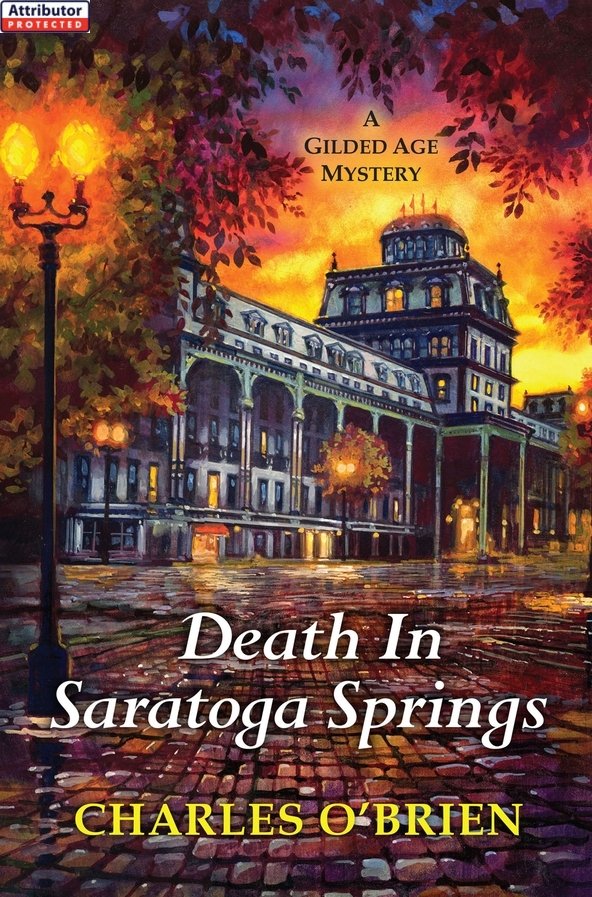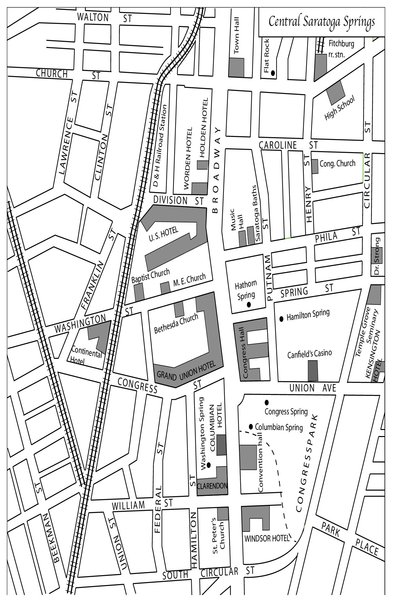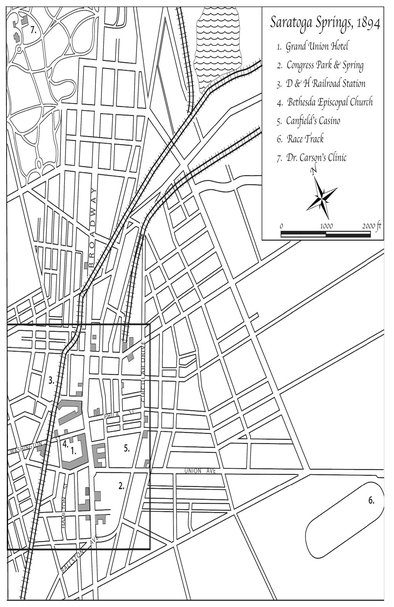Death in Saratoga Springs
Read Death in Saratoga Springs Online
Authors: Charles O'Brien


DEATH OF A ROBBER BARON
Â
DEATH IN SARATOGA SPRINGS
Â
Â
Â
Published by Kensington Publishing Corporation
A G
ILDED
A
GE
M
YSTERY
CHARLES O'BRIEN

KENSINGTON BOOKS

All copyrighted material within is Attributor Protected.
Title Page
Dedication
Acknowledgments
C
HAPTER
1 -
A New Case
C
HAPTER
2 -
War Hero
C
HAPTER
3 -
A Secret Villain
C
HAPTER
4 -
The Missing Body
C
HAPTER
5 -
Counterattack
C
HAPTER
6 -
An Old Soldier
C
HAPTER
7 -
The Last Day
C
HAPTER
8 -
Troubling News
C
HAPTER
9 -
Initial Impressions
C
HAPTER
10 -
Crucial Decision
C
HAPTER
11 -
Grieving Widow
C
HAPTER
12 -
The Investigation Widens
C
HAPTER
13 -
The Forager
C
HAPTER
14 -
Southern Suspects
C
HAPTER
15 -
Hattie's
C
HAPTER
16 -
The Search
C
HAPTER
17 -
Greed Frustrated
C
HAPTER
18 -
Police Detective
C
HAPTER
19 -
A Change of Heart
C
HAPTER
20 -
At the Track
C
HAPTER
21 -
A Cold Grave
C
HAPTER
22 -
Painful Revelation
C
HAPTER
23 -
Kinship's Duty
C
HAPTER
24 -
A Reluctant Patient
C
HAPTER
25 -
A Conspiracy?
C
HAPTER
26 -
Friend or Killer
C
HAPTER
27 -
Prescott Returns
C
HAPTER
28 -
Search
C
HAPTER
29 -
The Pit
C
HAPTER
30 -
Aftermath
C
HAPTER
31 -
The Past Examined
C
HAPTER
32 -
Hope
C
HAPTER
33 -
Deliverance
C
HAPTER
34 -
Finale
Author's Notes
Copyright Page
For Elvy
I wish to thank Andy Sheldon and Jennifer Krouse for helpful computer services. I am grateful also to Gudveig Baarli for diligently assisting with the maps, and to the editors and other professionals at Kensington who produced this book. My agent, Evan Marshall, and Adam Braver of the NY State Summer Writers Institute at Skidmore College, Saratoga Springs, read drafts of the novel and contributed much to its improvement. The librarians of the Saratoga Room at the Saratoga Springs Public Library generously offered skillful guidance into the rich historical sources of their Gilded Age city. Finally, my wife, Elvy, art historian, deserves special mention for her keen editorial eye and her moral support.


HAPTER
1
A New Case
New York City
Monday, February 5, 1894
Â
O
n a freezing Monday morning, Pamela Thompson shuffled over an icy patch on Irving Place, balancing on her steel-tipped walking stick. At the sign on the door, P
RESCOTT
AND
A
SSOCIATES
,
COUNSELORS-AT-LAW
, she was reminded that, two years ago, she had come here, a desperate woman seeking counsel. A year ago, the law firm employed her as an investigator, and soon Prescott himself became her mentor and friend.
She stepped into the warm reception room and left her stick by the door. Peter Yates, the firm's retired librarian and Pamela's friend, took her coat and hat. “The receptionist is ill. I'm helping out today. Mr. Prescott would like to see you in his office. You are to meet a visitor.”
A hint in Yates's voice made Pamela glance in a mirror and touch up her hair. He showed her into the room. A slim, elegant gentleman about fifty, a cane by his side, was sitting with Prescott. They rose to greet her. Prescott introduced the visitor as Mr. Virgil Crawford, the butler to the Crawford family. Pamela assumed from the family name that he was a relative. They gathered around the writing table.
Mr. Crawford addressed her politely in cultivated English with a Southern accent. His skin was fair in color; his eyes, almond shaped and a deep golden brown. His thick, curly hair was receding and turning gray, adding to an already strong impression of high intelligence. Pamela suddenly realized that this man was black and very likely once a slave.
Crawford took note of her surprise with the flicker of a smile, then said to her, “I have a problem: Our housekeeper's niece, Ruth Colt, disappeared a month ago. Without evidence of a crime, the police won't spend time or money to look for her. The detective in charge of missing persons, Larry White, recommended hiring a private investigator. So, I've come here. I'm acting on behalf of Mr. James Crawford, head of the family, and am prepared to contract with you for the search.”
“She's been gone a month?” Pamela asked. “By now, she might be in California or halfway to Hawaii. A search could be expensive.”
His eyes seemed to tease her, “The Crawfords have enough money.”
Prescott asked her, “Are you willing to look for the young woman? Our firm would place its resources at your disposal.”
“I am, indeed,” Pamela replied. “It's the kind of work I feel called to do.” She turned to Crawford. “Tell me more about the housekeeper and her niece.”
He leaned back in thoughtful reflection. “Martha Colt and Ruth are light-skinned black people who could pass for white. A widow, Martha has served the Crawford household for many years and is much respected. Ruth is fifteen and an orphan. A few months ago, she went to work as a chambermaid in a cheap hotel. When she disappeared and the police did nothing, Martha approached me for help.”
The girl's story both moved and intrigued Pamela. As far back as she could remember, she had felt compassion for poor, neglected, or abandoned children. For years she had helped provide them with food and clothing, shelter and counseling through St. Barnabas Mission on Mulberry Street. Having become a private investigator a year ago, she could now find them if they were lost.
As the meeting drew to an end, Crawford said to Pamela, “You should visit Mrs. Colt at our home on Washington Square. Enter from the rear at the service entrance.”
He also gave her an address on a side street near Washington Square. “That's my private office, where I do sensitive projects. Henceforth, we'll meet there.” He raised a cautionary finger. “Our investigation
must
be secret. We could encounter a murderer.”
Pamela left the room with the impression that Virgil Crawford was no ordinary butler who spent his day polishing the family silver or keeping track of household accounts. He acted like a secret agent dealing with issues of life and death. Why conceal the family's interest in this case? Did he have a hidden objective? She felt as if she was becoming a pawn in a dangerous game.
Â
That afternoon, Pamela approached the Crawford town house on the north side of Washington Square, a simple, elegant brick residence from the 1840s. She followed a walkway around the building to the service entrance and rang a bell. While waiting, she glanced at a tall brick shaft attached harmoniously to the rear of the building.
“Master James's elevator is inside the shaft, ma'am,” said the male servant who had opened the door. “The contraption runs on vertical rails with a system of ropes and pulleys and counterbalances. Ingenious, isn't it? He's crippled and uses a wheelchair. But his arms are very strong, and he manages the ropes by himself.”
The servant led her into a parlor and left to call Mrs. Colt. While waiting, Pamela studied a series of oil paintings that depicted sleek sailing ships. On a table below them stood a detailed model of a modern steamship. All the ships bore the same name,
Savannah Line.
“The Crawfords have been in the shipping business for fifty years,” Mrs. Colt remarked as she stepped into the room. “These days, Master James is in charge.”
Martha Colt was a wiry, older woman with a stern cast to her face, but she smiled graciously and showed Pamela into her room in the rear of the house. It had a view of the garden and the stable beyond. To judge from faint, savory odors rising from the kitchen below, dinner was being prepared.
On the wall hung a simple, naïve painting on wood of a Southern plantation. Asked about it, Martha brightened. “We were slaves. Daddy painted coaches, walls, and anything else that needed color. One of the Crawford family's tutors taught him how to sketch a scene and prepare a canvas and mix paints. He did this one in his spare time.”
In the middle of the picture was a large, square white house with wide verandas. To the left were farm buildings and a cluster of small slave cottages. To the right, Spanish moss dripped from the outstretched branches of giant live oaks. In the foreground, flower gardens encircled an ornamental pond. In the background were fields and orchards. Tiny black and white figures populated the scene.
“What a charming picture, its colors rich and strong,” Pamela exclaimed. “Your father had a delightful imagination. Is this a real place?”
“Yes, it's the Crawford plantation before the war. I was born there and worked in the kitchen with Virgil Crawford. He was the chef then, and his wife was the housekeeper.” She gestured to a tea table. “Please sit down.”
Over tea, Pamela asked about Ruth, the missing young woman.
“She was less than a proper Christian and difficult to raise,” said her aunt with a sigh. “She sassed me whenever I gave her a piece of advice. She would have her own way and live by herself.”
“Do you have a picture of her?”
“No, I don't, but she's petite, light skinned, and attractive enough to interest men. As a child, she broke her left leg. It healed badly and is a little shorter than the right one. She walks with a slight limp.”
Mrs. Colt didn't know her niece's friends but recalled a certain Aaron, a young black handyman at the Royal Hotel, where she worked. “I'll show you her room and the things she left at the hotel.”
The young woman's room was barely large enough for a chair, a table, and a bed. From beneath the bed the housekeeper pulled a small, battered suitcase. Inside were underclothes, a woolen skirt, a pair of working shoes and stockings, and a few pieces of cheap jewelry. Among scraps of paper were brief messages from the housekeeper and reminders of various duties in the hotel.
“Did she have any fancy clothes or valuables?”
“Indeed, she did. For her confirmation she got a pink silk dress and matching bonnet, and a gold bracelet with her initials. I can't find them. She was probably going to meet a man and was wearing them when she disappeared.”
Pamela suggested, “Perhaps she was.”
As Mrs. Colt was closing the suitcase, a small notebook, hidden in the lid, fell out. Pamela fingered through it.
Ruth had entered several names followed by dates, perhaps referring to the men she met. The next to last reference was to a Mr. Johnson with an address on Madison Square. The last entry was merely five numbers in a row,
14414,
hurriedly written and barely legible. Possibly a street address? Pamela would check them later. In the meantime, she would speak to Aaron, the girl's friend at the hotel.
Â
The Royal Hotel on Twenty-third Street in Chelsea was far from regal. The foyer reeked of stale tobacco, and its floor was grimy. Traveling salesmen in threadbare suits seemed to be its chief patrons.
At the reception desk, Pamela asked for Aaron, the handyman. Ten minutes later, he showed up, a harried look on his face. Pamela had caught him on the run. With a gentle smile and a small tip, Pamela persuaded him to sit with her in the foyer and talk.
He was a tall, slender, awkward young black man, gentle in his manner. A few sentences into their conversation, she realized to her surprise that he was speaking cultivated English.
He read her mind. “I don't want to be a handyman for the rest of my life in rat holes like this, so I'm attending night school.”
Pamela complimented him. “It must be hard to balance work and study. I hope you persevere. If you have time, would you tell me about Ruth Colt?”
“We were friends,” Aaron said shyly. “I thought we might get married. But when I asked her, she turned me down. âToo poor and too black,' she added, and then laughed at me.”
“That's cruel. I'm sorry.”
He shrugged. “She was a bright, lively girl, but quick with hurtful words, heedless more than mean. She liked to mimic people and sometimes she mocked them.”
“Were there other male friends?”
“Yes, she went out with several men and allowed herself more liberties than she should.”
“Do you mean, like a loose woman or a prostitute?”
“Oh no. When we were going together, Ruth was a good girl. Later, she seemed to trust men too much and was trying to get married to a rich one.”
“Can you describe the last man who showed interest in her?”
“He was white, older than the others, broad shouldered and tall, bearded, and walked with stiff legs. I hadn't seen him before. Called himself Mr. Johnson. When he registered, he gave us a business card that claimed he sold stocks and bonds at an address on Madison Square. His rough ways seemed to fascinate Ruth. I think he was a fraud.”
At Madison Square, Pamela checked Mr. Johnson's address. As she suspected, it was fictitious. A clerk in Prescott's office determined that Johnson's business credentials were bogus: No reputable broker had ever heard of him. The so-called Johnson was clearly an imposter or worse. Pamela's fears for Ruth Colt grew. She might have fallen into a predator's hands.
Â
The next day, Pamela woke in her bedroom to the sound of workmen clearing the street. She shuffled into the parlor and looked out a window. It had snowed during the night and covered Union Square with a soft, white blanket. She gave a wake-up call at the door of Francesca Ricci, the young woman living with her, and went through the apartment pulling up the shades.
During breakfast, the two women discussed the day's agenda; then Francesca went off to school. While lingering at the table with a cup of coffee, Pamela mulled over her investigation. Her thoughts came together in the imposter, Mr. Johnson, an older, lame man, but nonetheless strong enough to prey on young women. She telephoned Virgil Crawford for a meeting that afternoon.
His private office was located in a nondescript apartment building. At the door a concierge studied Pamela with a sharp eye. As Crawford had instructed, she asked to see Scipio Africanus, a fake name that showed off Crawford's grasp of ancient Roman history. The concierge replied, “Go to the top floor and down the hall to the back of the building. Last door on the right.”
The door lacked a nameplate, but she knocked anyway. A few seconds later, Crawford showed her into a small, tight room, and she sat facing him at his writing table. The telephone and several maps hung on the wall behind him. Through an open door she could see into a small parlor. His office was probably part of a full, compact apartment. File boxes and bookshelves covered the wall to his left. A window to his right admitted natural light and offered a view into a small garden enclosed by adjacent buildings.
“This is my den,” he said, pouring water for her and himself from a carafe. “I'm a butler with a wide range of duties. From here I protect the Crawford family's name and its business. For example, I check the credentials of every candidate for an upper-level position in the firm.” He raised his glass to her. “Now, tell me what you've learned thus far.”
She summarized her investigation and concluded that the disguised Mr. Johnson had caused Ruth Colt to disappear. She had probably never left the city.
When she finished, he remarked, “I agree that the man you've described is an imposter. Our next step is to determine his true identity. Have you heard of Captain Jed Crake, a distinguished cavalry officer under Sherman in the war and now the owner of a meatpacking business on West Fourteenth Street?”
“He's notorious,” replied Pamela. “When he laid workers off in a labor dispute, he impoverished several of our families at St. Barnabas Mission, on Mulberry Street.”
“Strange as it may sound, I suspect that Crake might be our disguised, predatory imposter.”
“Strange indeed!” Pamela exclaimed. “Crake may be flint-hearted, but he's surely not foolish. Such a rich, prominent, and successful person wouldn't risk everything for a brief sexual adventure with a chambermaid.” She felt uneasy about this conversation's direction. “Why have you suspected Crake?” she asked. “Surely Mr. Johnson's description could fit many men.”
